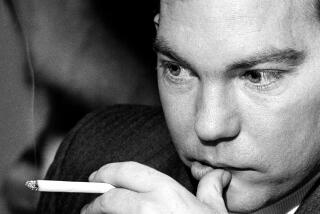From the Killing Fields of L.A., Justice at Last
- Share via
On March 25, 1985, the night he won an Academy Award, an overjoyed Dr. Haing S. Ngor rushed to the stage of the Dorothy Chandler Pavilion. He raised the Oscar over his head and said, “This is unbelievable, but so is my entire life!”
Yes, it was.
Yet life after death can be every bit as unbelievable.
Just one day after a tyrant who turned Ngor’s homeland into the killing fields of Cambodia is brought to meet his maker, Ngor’s murderers from the killing streets of Los Angeles are brought to justice.
Pol Pot is dead, a candle lights his head.
An estimated 60,000 Cambodians living in Southern California--a figure that once included Dr. Ngor--had by Thursday morning heard the good news about a ruthless man who destroyed millions of lives.
Most were glad Pol Pot had died, provided he had.
“I don’t believe at this time that it’s true,” said one woman, Thira Srey, standing outside the Cambodian Assn. of America’s headquarters in Long Beach.
No one could blame Cambodians for what they must be thinking. Corpus delicti.
A mere photograph of a body won’t do. Pol Pot had more lives than a cat. He was reported dead more often than Howard Hughes.
Maybe now, he really is.
Maybe now, Haing Ngor can rest in peace.
*
Hollywood was searching in the early 1980s for an actor to play Dith Pran, an interpreter and acquaintance of a New York Times reporter whose story would be made into a film. A casting agent saw nearly 300 expatriate Cambodians, looking for just the right type.
Ngor was no actor. He was a 35-year-old gynecologist.
A few actual actors questioned the wisdom of hiring someone so inexperienced for such a major role.
Ngor’s response to them was: “I got my license from the Khmer Rouge school of acting.”
He had come to Los Angeles directly from the killing fields. The real Dith Pran’s relatives had gotten out of Cambodia ahead of him. Ngor’s had not. He personally witnessed the deaths of many family members, most of them from starvation.
Up to 2 million Cambodians died of malnutrition, disease and executions in the mid-1970s, during Pol Pot’s reign of terror.
Ngor aided authorities who tried to track down Pol Pot and make him answer for his crimes. It was Ngor’s mission in life.
He lived near Chinatown.
He was noticed by a casting agent in a photograph at a wedding.
And he got the part of Dith Pran from director Roland Joffe, who said of Ngor’s audition, “When he looked out the window, he didn’t see the Warners parking lot. He saw Phnom Penh.”
For his performance, Ngor won an Oscar and a Golden Globe.
The doctor-actor was shot to death Feb. 25, 1996, a month shy of 11 years from the greatest night of his life.
Oscar in hand, Ngor shocked many by criticizing the film for not being totally realistic. He had wanted it to vividly portray the ways innocent Cambodians had been tortured by Khmer Rouge guerrillas.
The film did, however, bring Ngor one great joy, aside from fame and awards.
A niece in Paris he hadn’t seen in 10 years read a newspaper article about the film. Ngor later said, “I found all of my family that’s left.”
He was out of Cambodia, alive in California.
He was safe.
*
Pol Pot didn’t get him, but Tak Tan did.
A jury Thursday issued its verdict that Tan was an accomplice in Haing S. Ngor’s murder. Two separate juries had already found Jason Chan and Indra Lim, reputed gang members, guilty of shooting Ngor during a bungled robbery attempt, but waited for Tan’s jury to come in before releasing their verdicts.
Sophia Ngor, the victim’s niece, was here to hear that last verdict.
“My uncle, when he spoke to students and young people, he always encouraged them to stay in school and to stay away from gang activity,” she said. “I will always cherish his memory.”
Cambodians can join her.
A good man went to his reward. Now, the evil men will get theirs.
More to Read
Sign up for Essential California
The most important California stories and recommendations in your inbox every morning.
You may occasionally receive promotional content from the Los Angeles Times.










